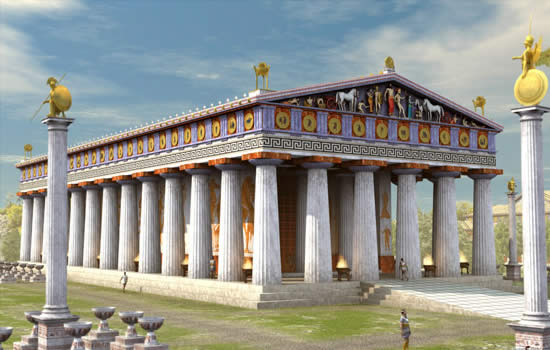 |
| Olympia is in the Peloponnese on the western coast. |
(Published by http://www.vacationstogo.com/images/ports/maps/170_w.gif)
History of Olympia
Olympia was first inhabited around 2000 BC based on the earliest artifacts found, but some scholars believe it to be earlier. Around 1100 BC, the earliest settlers were invaded by a group of people called Aetolians. The Aetolians formed the region into a district called Elis, where the first Olympic festival was organized by the authorities of Elis. Because Olympia started out as the sanctuary for followers of Zeus, the Olympic Games were held in his honor. The first Olympic Games were traditionally said to have been held in 776 BC.
As the century went on, Elis’ power diminished and the sanctuary was taken over by Pisatans (people of a nearby village called Pisa) in 676 BC, who kept organizing the games until late 7th century BC. In 580 BC, the people of Elis (the Aetolians) allied with Sparta and took over Pisa, thus regaining control over Olympia.
 |
| A model of what Olympia is thought to have looked like |
(published by http://upload.wikimedia.org/wikipedia/commons/thumb/3/35/Model_of_ancient_Olympia.jpg/800px-Model_of_ancient_Olympia.jpg)
The Temple of Zeus
(published by http://www.destination360.com/europe/greece/images/s/temple-of-olympian-zeus.jpg)
 |
| Ruins of the Temple of Zeus |
 |
| Model of the Temple of Zeus (published by http://www.olympia-greece.org/templeofzeus1.jpg) |
Perhaps one of the most famous artifacts of the Temple of Zeus, the Statue of Zeus was proclaimed as one of the Seven Wonders of the Ancient World. It was approximately 43 feet high and sculpted by the sculptor Phidias who had his workshop on the site of Olympia. It took twelve years to complete it.
In 330 AD, Constantine removed the statue and took it to Constantinople, where it was destroyed in a fire around 400 to 500 AD.
(published by http://upload.wikimedia.org/wikipedia/commons
/1/17/Zeus_Hermitage_St._Petersburg_20021009.jpg)
 |
| The Statue of Zeus |
The Olympic Games
 |
| Discus Throwing |
(published by http://humanitieslab.stanford.edu/ceramics/991)
The Olympics were first held in 776 BC (as tradition dates it). They were held every four years for the representatives of the various city-states of Ancient Greece. It eventually became a political tool used by city-states to assert dominance over their rivals. When the Romans took over Olympia, they continued the tradition of the Olympics. However, around 300 AD, earthquakes caused extensive damage to the sanctuary and various stadiums of Olympia. Despite the damage, the Olympic Games continued to be held until 393 AD, when the Roman Emperor, Theodosius I, implemented a ban on the games because of its pagan-like rituals and symbolism.
The Modern Olympics were revived in 1896 under the formation of an international committee, and the first Modern Olympics was held in Greece as a tribute to the ancient games.
The Olympic Torch
The Olympic Torch is ignited several months before the opening ceremony of the Olympic Games at the site of the ancient Olympics in Olympia, Greece. Eleven women, called the Vestal Virgins, perform a ceremony in which the torch is kindled by the light of the Sun, whose rays are concentrated by a parabolic mirror.
 |
| Lighting of the Olympic Torch |
(published by http://www.minnpost.com/_asset/4mdmzt/
mp_main_wide/OlympicTorchCeremony.jpg)
Olympia through the Years
As the centuries went on, the site was essentially buried underground, with the reason widely believed due to mineral and other deposits as a result of continual flooding. The exact site was rediscovered in 1766 by Richard Chandler, but the first excavation was not carried out until 1829 by the French. From the 1870s onward, the excavation was the responsibility of the German Archaeological Institute at Athens.
 |
| Ruins of Olympia |
Olympie_Temple_Zeus.JPG/800px-Olympie_Temple_Zeus.JPG)
Olympia is now a popular tourist destination, and one of its most visited sites along with the ruins of the Olympic stadiums and various temples, is the Historical Museum of the Olympic Games.
Olympia is now a popular tourist destination, and one of its most visited sites along with the ruins of the Olympic stadiums and various temples, is the Historical Museum of the Olympic Games.
No comments:
Post a Comment